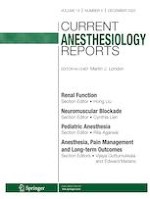Erschienen in:

05.08.2023 | Renal Function (H Liu, Section Editor)
The Relationship Between Intraoperative Tissue Oxygenation Monitoring and Postoperative Renal Function After Cardiac Surgery
verfasst von:
Joseph Walpole, Wei Dong Gao
Erschienen in:
Current Anesthesiology Reports
|
Ausgabe 4/2023
Einloggen, um Zugang zu erhalten
Abstract
Purpose of Review
Cardiac surgery-associated acute kidney injury (CSA-AKI) is a global source of patient morbidity and mortality in the perioperative period. Prior attempts to predict vulnerable or high-risk patients using available data have not coalesced into a predictive model with widespread clinical utility. Emerging technology is allowing for more direct measures of renal oxygen saturation which has demonstrated promising results as a novel predictor of CSA-AKI. In this review, we explore several recent approaches to measuring renal tissue oxygenation intraoperatively, spanning preclinical and clinical trials in adults undergoing cardiac surgery.
Recent Findings
By more directly interrogating renal oxygenation rather than relying on surrogate markers (pulse oximetry, cardiac output, hypotension, etc.), new methods (near infrared, photoacoustic imaging, urine oxygen saturation, etc.) seek to link the pathogenesis (renal hypoxia) to the clinical outcome (CSA-AKI). The studies are often smaller cohorts; however, their data are largely in agreement that measured reduced renal tissue oxygenation during and immediately after cardiac surgery may independently predict CSA-AKI that develops days later.
Summary
No single technique has emerged as the definitive best measure of renal oxygenation; however, the value added by more accurately predicting CSA-AKI cannot be understated. Any advance towards predicting, treating, and preventing CSA-AKI will directly lead to improved patient outcomes.











